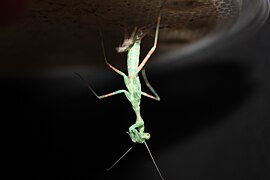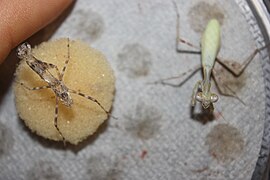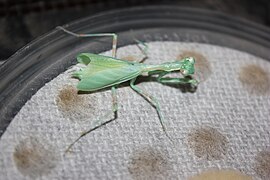
The Carolina mantis is a species of praying mantis of the subfamily Stagmomantinae.

The Chinese mantis is a species of mantis native to Asia and the nearby islands. In 1896 this species was accidentally introduced by a nurseryperson at Mt. Airy near Philadelphia, United States. Tenodera sinensis often is erroneously referred to as Tenodera aridifolia sinensis because it was at first described as a subspecies of Tenodera aridifolia, but Tenodera sinensis is now established as a full species.

Hymenopodidae is a family of the order Mantodea (mantises), which contains six subfamilies. Some of the species in this family mimic flowers and are found camouflaged among them; these are called flower mantises. Their coloration is aggressive mimicry, luring prey to approach close enough to be seized and eaten.

Miomantis caffra is a species of praying mantis native to southern Africa. It appeared in New Zealand in 1978, and was found more recently in Portugal and Los Angeles, USA, likely spread through the exotic pet trade. Females are facultatively parthenogenetic and unmated females can produce viable offspring.

Iris oratoria, known by the common name Mediterranean mantis or iris mantis, is a widespread species of praying mantis native to Europe. It is found as an introduced species in the Middle East, Western Asia and the United States. Iris oratoria invaded southern California in the 1930s and seems to be spreading.

Phyllocrania paradoxa, common name ghost mantis, is a small species of mantis from Africa remarkable for its leaf-like body. It is one of the three species in the genus Phyllocrania. It is known for its distinct and exclusive camouflaged appearance of a dry weathered leaf.

Tenodera angustipennis is a species of mantis native to Asia and nearby areas of Oceania. The species was introduced and became established in the eastern United States. Tenodera angustipennis was noticed as early as 1921 in Aberdeen, Maryland, but that occurrence was not noted in a published record until 1933.

Sphodromantis viridis is a species of praying mantis that is kept worldwide as a pet. Its common names include African mantis, giant African mantis, and bush mantis.
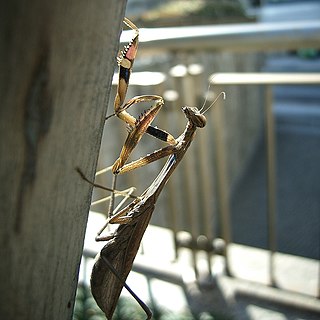
Statilia maculata, common name Asian jumping mantis or "小蟷螂", ko-kamakiri or "좀사마귀", joem-sa-ma-gui, is a species of mantis native to Asia that can be found in China and Japan and Korea and Sri Lanka.

Ameles spallanzania, common name European dwarf mantis, is a species of praying mantis.
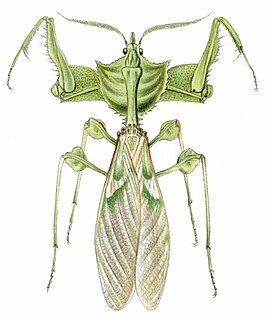
Idolomantis is a genus of praying mantises in the family Empusidae. It is represented by a single species, Idolomantis diabolica, commonly known as the devil's flower mantis or giant devil's flower mantis. It is one of the largest species of praying mantises, and is possibly the largest that mimics flowers

African mantis and African praying mantis are common names for many species of praying mantis native to Africa.

Orthodera novaezealandiae, known as the New Zealand mantis or the New Zealand praying mantis, is a species of praying mantis which is, as both the scientific name and common names suggest, indigenous and endemic to New Zealand.
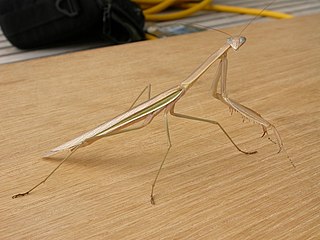
Tenodera australasiae, the purple-winged mantis, is species of praying mantis. Found in Australia, it is common in most parts of Brisbane (QLD). Both males and females are capable of flight. The species has not been shown to be parthenogenetic.
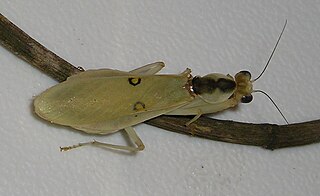
Chloroharpax is a genus of praying mantis in the family Hymenopodidae. The genus is monotypic, being represented by a single species, Chloroharpax modesta, commonly called the Nigerian flower mantis, and is found across West Africa.
Miomantis abyssinica is a species of praying mantis in the family Miomantidae, native to North Africa.

Miomantis paykullii is a species of praying mantis in the genus Miomantis in the order Mantodea.
Acanthops falcata, common name South American dead leaf mantis or boxer mantis, is a species of praying mantis in the subfamily Acanthopinae of the family Acanthopidae and is one of many praying mantises from various genera that resembles a dead leaf.

Mantises are an order (Mantodea) of insects that contains over 2,400 species in about 430 genera in 33 families. The largest family is the Mantidae ("mantids"). Mantises are distributed worldwide in temperate and tropical habitats. They have triangular heads with bulging eyes supported on flexible necks. Their elongated bodies may or may not have wings, but all Mantodea have forelegs that are greatly enlarged and adapted for catching and gripping prey; their upright posture, while remaining stationary with forearms folded, has led to the common name praying mantis.



